
The Battle of Palmito Ranch, also known as the Battle of Palmito Hill, is considered by some criteria as the final battle of the American Civil War. It was fought May 12 and 13, 1865, on the banks of the Rio Grande east of Brownsville, Texas, and a few miles from the seaport of Los Brazos de Santiago, at the southern tip of Texas. The battle took place more than a month after the general surrender of Confederate forces to Union forces at Appomattox Court House, which had since been communicated to both commanders at Palmito, and in the intervening weeks the Confederacy had collapsed entirely, so it could also be classified as a postwar action.
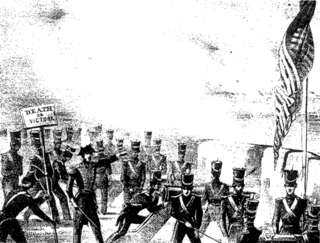
The siege of Fort Texas marked the beginning of active campaigning by the armies of the United States and Mexico during the Mexican–American War. The battle is sometimes called the siege of Fort Brown. Major Jacob Brown, not to be confused with War of 1812 General Jacob Brown, was one of the two Americans killed in action.

Buffalo Soldiers were United States Army regiments formed during the 19th century to serve on the American frontier that primarily comprised African Americans. On September 21, 1866, the 10th Cavalry Regiment was formed at Fort Leavenworth, Kansas. The nickname "Buffalo Soldiers" was purportedly given to the regiment by Native Americans who fought against them in the American Indian Wars, and the term eventually became synonymous with all of the African American U.S. Army regiments established in 1866, including the 9th Cavalry Regiment, 10th Cavalry Regiment, 24th Infantry Regiment, 25th Infantry Regiment and 38th Infantry Regiment.

Fort Leavenworth is a United States Army installation located in Leavenworth County, Kansas, in the city of Leavenworth. Built in 1827, it is the second oldest active United States Army post west of Washington, D.C., and the oldest permanent settlement in Kansas. Fort Leavenworth has been historically known as the "Intellectual Center of the Army."

The Fifth Military District of the U.S. Army was one of five temporary administrative units of the U.S. War Department that existed in the American South from 1867 to 1870. The district was stipulated by the Reconstruction Acts during the Reconstruction period following the American Civil War. It covered the states of Texas and Louisiana.
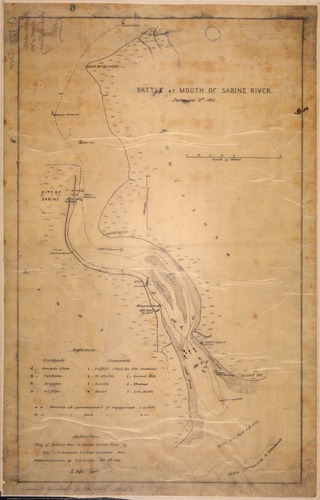
The Second Battle of Sabine Pass was a failed Union Army attempt to invade the Confederate state of Texas during the American Civil War. The Union Navy supported the effort and lost three gunboats during the battle, two captured and one destroyed.
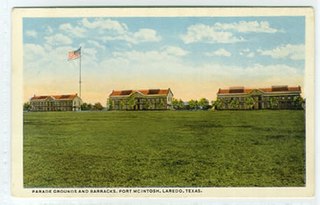
Fort McIntosh was a U.S. Army base in Laredo, Webb County, Texas, from 1849 to 1946.
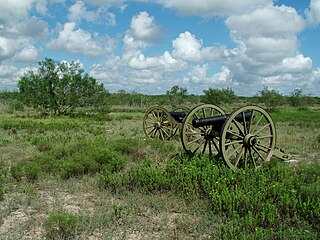
Palo Alto Battlefield National Historical Park near Brownsville, Texas, United States, is a National Park Service unit which preserves the grounds of the May 8, 1846, Battle of Palo Alto. It was the first major conflict in a border dispute that soon precipitated the Mexican–American War. The United States Army victory here made the invasion of Mexico possible. The historic site portrays the battle and the war, and its causes and consequences, from the perspectives of both the United States and Mexico.

John Salmon Ford, better known as "Rip" Ford, was a member of the Republic of Texas Congress and later the Texas Senate, and mayor of Brownsville, Texas. He was also a Texas Ranger, a Confederate colonel, a doctor, a lawyer, and a journalist and newspaper owner. Ford commanded men during the Antelope Hills expedition, and he later commanded the Confederate forces in what was arguably the last engagement of the American Civil War, the Battle of Palmito Ranch on May 12–13, 1865. It was a Confederate victory, but as it occurred more than a month after Robert E. Lee's surrender, it did not affect the war's outcome.

Fort Duncan was a United States Army base, set up to protect the first U.S. settlement on the Rio Grande near the current town of Eagle Pass, Texas.

The Defense of Cincinnati occurred during what is now referred to as the Confederate Heartland Offensive or Kentucky Campaign of the American Civil War, from September 1 through September 13, 1862. Confederate Brigadier General Henry Heth was sent north from Lexington, Kentucky, to threaten Cincinnati, Ohio, then the sixth-largest city in the United States. Heth was under orders from his superior, Major General Edmund Kirby Smith, not to attack the city, but to instead make a "demonstration". Once Heth arrived and reconnoitered the defenses, he realized an attack was pointless. After a few minor skirmishes, he took his men back to Lexington.

The Fort McKavett State Historic Site is a former United States Army installation located in Menard County, Texas. The fort was first established in 1852 as part of a line of forts in Texas intended to protect migrants traveling to California. The fort was deemed unnecessary and abandoned in 1859 and was occupied by settlers. From 1861 to 1863, during the American Civil War, the fort became an outpost of Confederate forces on the Texas frontier until they left for other theaters of the war. When the US Army returned to Texas in the later 1860s, the fort was reoccupied and rebuilt, and became a base for the "Buffalo Soldier", or all-African American, 24th Infantry and 9th Cavalry Regiments.

Liendo Plantation is an historic cotton plantation in Waller County, Texas, United States. Named after its original owner, José Justo Liendo, the plantation was purchased in 1873 by sculptor Elisabet Ney and her husband, physician Edmund Montgomery.
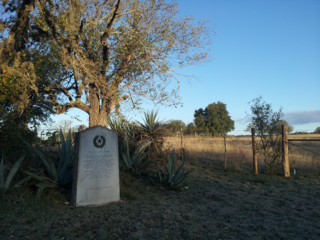
Camp Verde was a United States Army facility established on July 8, 1856 in Kerr County, Texas along the road from San Antonio to El Paso.
Fort Quitman was a United States Army installation on the Rio Grande in Texas, south of present-day Sierra Blanca, 20 miles southeast of McNary in southern Hudspeth County. The fort, now a ghost town, was named for former Mississippi Governor John A. Quitman, who served as a major general under Zachary Taylor during the Mexican–American War.

Fort Mason was established on July 6, 1851, in present-day Mason County, Texas. It was named in honor of George Thomson Mason, a United States Army second lieutenant killed in the Thornton Affair during the Mexican–American War near Brownsville, April 25, 1846. At various times from 1856 to 1861, this was the home fort for Albert Sidney Johnston, George H. Thomas, Earl Van Dorn, and Robert E. Lee. The fort was abandoned by the military in the 1870s, and restored by a group of local citizens in 1975. Visitors can tour the reproduction officers' quarters at the Fort Mason Museum.
The Battle of Brownsville took place on November 2–6, 1863 during the American Civil War. It was a successful effort on behalf of the Union Army to disrupt Confederate blockade runners along the Gulf Coast in Texas. The Union assault precipitated the capture of Matamoros by a force of Mexican patriots, led by exiled officers living in Brownsville.

Fort Clark was a frontier fort located just off U.S. Route 90 near Brackettville, in Kinney County, Texas, United States. It later became the headquarters for the 2nd Cavalry Division. The Fort Clark Historic District was added to the National Register of Historic Places on December 6, 1979. The Commanding Officer's Quarters at Fort Clark were designated a Recorded Texas Historic Landmark in 1988. The Fort Clark Guardhouse became a Recorded Texas Historic Landmark in 1962. The Fort Clark Officers' Row Quarters were designated a Recorded Texas Historic Landmark in 1991.
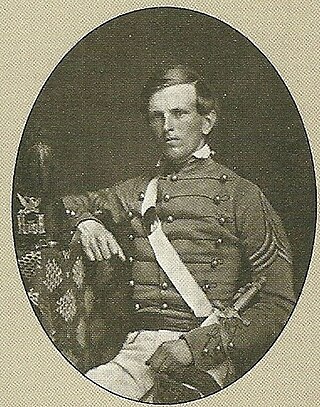
Manning Marius Kimmel was a military officer who served on both sides of the American Civil War. He entered the United States Military Academy at West Point in 1853 and graduated in 1857. After initially fighting for the Union, he switched sides to the Confederacy, one of four West Point graduates to fight on both sides during the war. In the Confederate Army, he served as adjutant general and assistant adjutant general on the staff of generals Benjamin McCulloch and Earl Van Dorn, and as inspector general on John Magruder's staff. He was the father of Admiral Husband E. Kimmel, who commanded the United States Pacific Fleet during the Attack on Pearl Harbor.
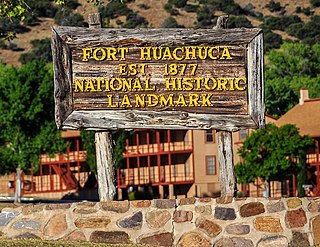
This is a list with images of some of the historic structures and places in the Fort Huachuca National Historic District in Arizona. The district, also known as Old Fort Huachuca, is located within Fort Huachuca an active United States Army installation under the command of the United States Army Installation Management Command. The fort sits at the base of the Huachuca Mountains four miles west of the town of Sierra Vista, on AZ 90 in Cochise County, Arizona.































